Mixed lot (2 items): Nuristan, Afghanistan: Two typical Kafiristani spiral chokers made of weak silver alloy and decorated with two red and blue glass gemstones respectively.
Mixed lot (2 items): Nuristan, Afghanistan: Two typical Kafiristani spiral chokers made of weak silver alloy and decorated with two red and blue glass gemstones respectively.

Northeast Afghanistan and the western region of North Pakistan are an old cultural and ethnological retreat, where, in spacious valleys of the Hindu Kush, lived the Kafir (‘unbeliever’) tribes. With their own languages, religion and culture. They were only (forcefully) converted to Islam in the winter of 1895/96 in a military campaign by the Afghan Shah Abdur Rahman (for a more detailed explanation see cat. no. 160). Both spiral chokers presented here are typical ornaments of the pre-Islamic Kafiristanis, worn only by high-ranking men and their women and daughters. The chokers are made of thick silver alloy wire curled into spirals. Soldered together at the ends the spirals extend into bent-bud pommels. Soldered atop the widest spot are then decorative cast appliqués with colourful glass ‘gemstones’ embedded in them. This choker type is thought to have been in production in the Swat Valley (North Pakistan) and traded westward to the Kafiristanis. Shortly after 1900 their production stopped. Dimensions: 14.5 cm x 16 cm; 17 cm x 19 cm.19th century to around 1900. (ME)
Provenance: Hungarian Private Collection.
Lit.: 'Schmuck in Afghanistan' by Alfred Janata, ill. 30.
Esperto: Prof. Erwin Melchardt
 Prof. Erwin Melchardt
Prof. Erwin Melchardt
+43-1-515 60-465
erwin.melchardt@dorotheum.at
02.11.2015 - 14:00
- Prezzo di partenza:
-
EUR 450,-
Mixed lot (2 items): Nuristan, Afghanistan: Two typical Kafiristani spiral chokers made of weak silver alloy and decorated with two red and blue glass gemstones respectively.
Northeast Afghanistan and the western region of North Pakistan are an old cultural and ethnological retreat, where, in spacious valleys of the Hindu Kush, lived the Kafir (‘unbeliever’) tribes. With their own languages, religion and culture. They were only (forcefully) converted to Islam in the winter of 1895/96 in a military campaign by the Afghan Shah Abdur Rahman (for a more detailed explanation see cat. no. 160). Both spiral chokers presented here are typical ornaments of the pre-Islamic Kafiristanis, worn only by high-ranking men and their women and daughters. The chokers are made of thick silver alloy wire curled into spirals. Soldered together at the ends the spirals extend into bent-bud pommels. Soldered atop the widest spot are then decorative cast appliqués with colourful glass ‘gemstones’ embedded in them. This choker type is thought to have been in production in the Swat Valley (North Pakistan) and traded westward to the Kafiristanis. Shortly after 1900 their production stopped. Dimensions: 14.5 cm x 16 cm; 17 cm x 19 cm.19th century to around 1900. (ME)
Provenance: Hungarian Private Collection.
Lit.: 'Schmuck in Afghanistan' by Alfred Janata, ill. 30.
Esperto: Prof. Erwin Melchardt
 Prof. Erwin Melchardt
Prof. Erwin Melchardt
+43-1-515 60-465
erwin.melchardt@dorotheum.at
|
Hotline dell'acquirente
lun-ven: 10.00 - 17.00
kundendienst@dorotheum.at +43 1 515 60 200 |
| Asta: | Tribal Art |
| Tipo d'asta: | Asta in sala |
| Data: | 02.11.2015 - 14:00 |
| Luogo dell'asta: | Wien | Palais Dorotheum |
| Esposizione: | 28.10. - 02.11.2015 |
